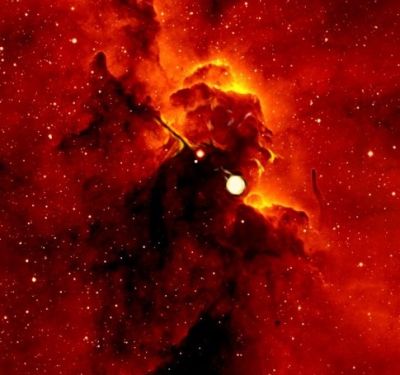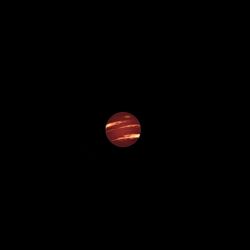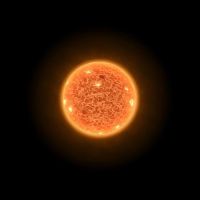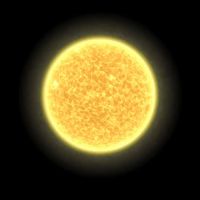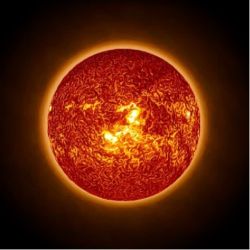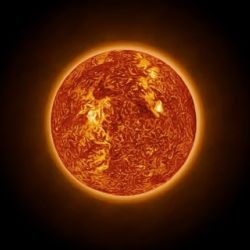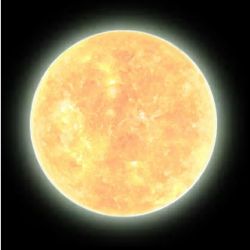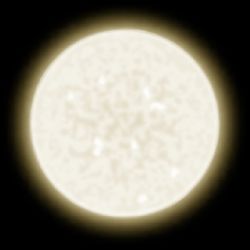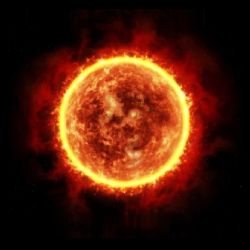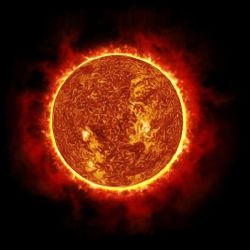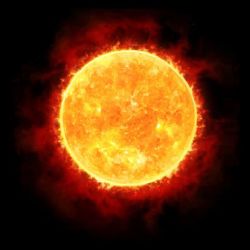Star
A Star is an astrographic spatial object composed of a massive incandescent sphere of plasma held together by its own gravity.
Overview
Formed within nebulae, a star is formed as the inward gravitational pressure due to in-falling gas balances against the rising outward thermal pressure of the core of the gas cloud due to the collapse. Stars are generally found grouped together into galaxies, of which Galaxias is the name of the home galaxy of Humaniti, containing an estimated 400 billion stars. Nearly 200 billion galaxies make up the observable universe. Some stars have been found in intergalactic space, however, having likely been ejected from galaxies that collided or otherwise interacted gravitationally.
Description
General Stellar Populations
Population III stars
Population III stars, or "extremely metal-poor stars", are the oldest stars that have ever existed, having lived and died within the first 2 billion years of the existence of the universe. Population III stars are characterized by virtually zero metallicity, as it is these stars that were largely responsible for having generated the elements heavier than helium through nucleosynthesis in their cores, and having spread heavier elements into the cosmos through supernovae. Population III stars are believed to have been extremely hot and massive stars of several hundred solar masses. There are no surviving Population III stars in the universe today.
Population II stars
Population II stars, or "metal-poor stars", are old stars of generally low metallicity which were formed during the generations of star formation after the initial stars of the Population III generation. Population II stars are commonly found in the galactic halo and globular clusters, and are believed to be responsible for the creation of the remaining heavier elements of the periodic table.
Population I stars
Population I stars, or "metal-rich stars", are the most recent generation of stars, generally of higher metallicity, of which the Terran primary star Sol is an example. They are commonly found in the spiral arms of spiral galaxies.
Origin & Formation
Stars are typically formed in a specific type of collapsing interstellar cloud known as a molecular cloud. Interstellar clouds are regions of gas, dust, and plasma that have a higher average density than the general interstellar medium. They are typically composed of about 70% hydrogen, the bulk of the remainder being helium with traces of other elements. Interstellar clouds can be classified into 3 general types based on the primary form of hydrogen found within:
- Neutral Clouds (H I regions - formed of atomic hydrogen)
- Ionized Clouds (H II regions - formed of ionized hydrogen [i.e. "Plasma"])
- Molecular Clouds (Molecular Hydrogen - formed of H2)
Under normal circumstances interstellar clouds exist in a state of hydrostatic equilibrium, in which the natural self-gravitation that would otherwise cause the cloud to collapse is balanced by the outward pressure within the cloud due to motion of the atoms and molecules that compose it. Star formation is normally caused by a triggering event which locally disturbs this equilibrium, causing runaway local collapsing regions within the cloud. Such causes can be the collision of one cloud with another, or the shock-wave within the interstellar medium caused by a nearby supernova explosion.
Once triggered, a collapsing region will begin to increase in temperature as the density of the cloud increases, while at the same time rotating with ever-increasing net angular velocity due to conservation of angular momentum acting upon the small non-zero initial net angular momentum of the collapsing region as the cloud contracts. As the cloud-region continues to contract under self-gravitation, the opacity of the gas to thermal radiation will increase (trapping the heat internally) and the growing outward thermal pressure of the cloud will cause the rate of contraction to slow, forming a hot incandescent core region known as a proto-star. As accretion of gas onto the proto-star continues, the mass of the proto-star will continue to grow, increasing its gravitational attraction and compressing the core region of the proto-star to ever higher densities. Eventually as the accretion process runs toward completion, a state of quasi-hydrostatic equilibrium will again be reached, as the outward thermal pressure within the proto-star begins to counteract the inward gravitational pressure due to the proto-star's own mass. As slow compaction continues the proto-star will enter onto one of three paths dependent upon the final mass of the proto-stellar body, becoming either a Sub-Brown Dwarf, a Brown Dwarf, or a Pre-Main Sequence Star.
Sub-Brown Dwarf
A Sub-Brown Dwarf is formed from a collapsing molecular cloud whose proto-star mass produces insufficient core temperature and pressure to initiate any type of thermonuclear burning. The threshold for such pressures is typically estimated to be about 13 MJ. Having failed to reach this minimum mass threshold, a sub-brown dwarf will simply continue to slowly contract after accretion has completed, slowly radiating its heat away from its surface thermally until it eventually cools back to 2.7 K over many billions of years.
Brown Dwarf
A proto-star whose final mass falls between 13 MJ and 85 MJ (=0.08 MSol) will form into a Brown Dwarf. A Brown Dwarf has sufficient mass to produce temperatures and pressures sufficient to initiate deuterium-burning in its core, and if above ~ 65 MJ, to initiate lithium-burning as well. It has insufficient temperature and pressure to initiate hydrogen burning via the proton-proton chain, however. Since a small percentage of the initial cloud of gas that formed the star is composed of molecules other than light-H2 or He, a certain small fraction of this gas will be composed of heavy hydrogen (i.e. deuterium) and lithium isotopes, among other substances. Since there is such a small percentage of HD, D2, and Li within the gas mix, the time spent fusing these elements is relatively short on the timescale of stellar lifespans, after which all fusion reactions shut down. The Brown Dwarf will once again begin to slowly contract and radiate its heat away from its surface thermally (much as a Sub-Brown Dwarf does), its low-mass core contracting to form an electron-degenerate mass that supports the weight of the star entirely through degeneracy pressure. Brown Dwarfs typically fall within the range of stellar spectra from M6.5 V to M9.5 V (overlapping red main-sequence dwarfs), and also include classes L, T, and Y.
Pre-Main Sequence Star
A proto-star that achieves a mass greater than 85 MJ (= 0.08 MSol) has sufficient pressure and temperature that in addition to Lithium and Deuterium burning, it can eventually initiate light hydrogen burning via the proton-proton chain and/or the CNO Cycle. The phase of compaction between the proto-star's final stage of gas-accretion and the ignition of proton-proton burning is known as the pre-main sequence phase. Stars in this phase whose mass falls between 0.08-2.0 MSol are generally known as T-Tauri stars, whereas those between 2-8 MSol form Herbig Ae/Be stars. Stars of greater than 8 MSol are generally massive enough to not go through an observable pre-main sequence phase, as they are already burning hydrogen by the time they become optically visible from within their molecular cloud.
Main Sequence
Main Sequence Stars (particularly the smaller ones in spectral classes "G" thru "M") are also sometimes referred to as "dwarf" stars or main sequence dwarfs.
A Pre-main-sequence star will eventually compact sufficiently to create pressures and temperatures conducive to thermonuclear burning via the proton-proton chain and/or the CNO Cycle, at which point the star has become a Main Sequence Star. All main sequence stars generate some fraction of their energy production via each of these processes, but as the CNO Cycle generally occurs at higher ignition temperatures, the relative reaction rate for each of these reactions in any given star is expressed as a percentage called the reaction cross-section, indicating the amount of fusion taking place by each specific reaction within a given stellar core.
- Hydrogen Burning (Proton-Proton Chain). The Proton-Proton Chain is a thermonuclear fusion process which is the dominant energy generation process for main sequence stars of less than 1.3 MSol, and generally requires temperatures in excess of 4 megakelvins. There are several intermediary steps within the proton-proton chain, but the end result is that 4 protons (hydrogen nuclei) produce 1 helium nucleus (alpha particle) plus two positrons and two neutrinos, along with 2 gamma photons and energy. The two positrons likewise rapidly annihilate two electrons in the surrounding plasma, liberating additional energy in the form of 4 additional gamma photons:
- 4 1H → 4He + 2e+ + 2νe + 2 γ and 2e+ + 2e- → 4 γ
- Hydrogen Burning (CNO Cycle). The CNO Cycle is a catalytic thermonuclear fusion process which is the dominant energy generation process for main sequence stars of greater than 1.3 MSol, and generally requires temperatures in excess of 15 megakelvins. The CNO Cycle energy output increases more rapidly with increasing temperatures than that of the proton-proton chain, however, becoming the dominant form of thermonuclear fusion at about 17 megakelvins. The net reaction for the CNO Cycle is the same as that listed above for the proton-proton chain, with same number and kind of reactants and the same end products. However, the CNO Cycle utilizes various isotopes of carbon, nitrogen, and oxygen catalytically in one of four possible reaction pathways in the reaction process.
In stars of sufficiently low mass (less than about 0.25-0.50 MSol), the heat transport mechanism within the star is primarily convective rather than radiative, meaning that heat is primarily transported by convection currents within the plasma. As a result, all of the hydrogen within the star is cycled through the reaction core, as well as the resultant helium product, and the star will continue to fuse hydrogen until the very end of its life, at which time (as helium ash continues to build up and eventually sink toward the center of the star) it will directly evolve into a helium degenerate dwarf.
Main sequence stars of higher mass typically transport heat primarily though the radiative heat transport process rather than convection, meaning that heat is primarily radiated away from the core via electromagnetic radiation. As main sequence stars of higher mass evolve, they build up an "ash" of 4He product that is non-reactive in the fusion process at the temperature ranges listed above. This 4He ash is not cycled throughout the star as it is in convective heat transport, and it thus sinks to the center of the core and absorbs heat without adding to the reaction processes within the star. As time progresses, this increasing amount of ash begins to slow the reaction rate of fusing hydrogen as it absorbs energy from the system, causing the core to begin to contract under its own weight due to the decreased reaction output, and subsequently causing a rise in core temperature. As the core temperature rises through gravitational contraction, the outer layers of the star are heated and driven slowly outward. The eventual result of this process will be the evolution of the star into a subgiant, which will itself eventually evolve into either a giant or supergiant star.
Note that some stars which are otherwise in their main sequence phase are sometimes classed as subgiants due to abnormally high luminosity as a result of unusual chemical composition, high metallicity, or other undetermined oddities. Likewise, some stars which are otherwise considered to be on the main sequence evolutionarily exhibit an unusually low luminosity and higher temperature than would otherwise be expected, usually due to a low metallicity which renders the stellar atmosphere less opaque and therefore less able to trap heat. Such stars are classified as subdwarf stars.
Stellar Evolution - Post Main Sequence
As a star ages and converts its supply of hydrogen into helium, changes in resultant energy output from the star will slowly cause the star to evolve in one of several directions depending on its mass.
Blue Dwarf
For main sequence "red dwarf" stars of less than about 0.50 MSol (approximately stellar types M1.5 V thru M9 V), there is insufficient mass to create the pressure and temperature necessary to fuse the helium product of proton-proton fusion into heavier elements. As the hydrogen from the star gets cycled throughout the entire star (including the reaction core), it will have the opportunity to continue hydrogen burning until virtually all of its hydrogen is used up. The helium ash from this reaction will begin to form a growing degenerate helium core within the star as hydrogen burning continues to occur at higher levels within the star. As this process continues over several hundred billion to trillions of years, the temperature of the outer layers of the star will gradually increase with increasing luminosity, the color of the star gradually evolving from the pinkish-orange coloration of a "red dwarf" toward a blue-white hue. This final "Blue Dwarf" will eventually burn out as its hydrogen supply becomes exhausted, leaving behind a radiant blue-white-hued helium degenerate dwarf star in which all nuclear reactions have ceased, slowly cooling over eons back through the spectrum down toward red/infra-red and eventually to black multiple hundreds of trillions of years in the future.
Giant Star
As a main sequence star of greater than 0.4-0.5 MSol ages and generates a build-up of helium ash at its core, it begins to burn its hydrogen in a shell surrounding the inert helium core, causing the outer layers of the star to begin to expand and cool as the core contracts and heats up, increasing the rate of hydrogen burning in the surrounding shell as a consequence. As the star enters this subgiant phase, the color and temperature of the star's photosphere cools and begins to move slowly toward the "red" direction of the spectrum. Eventually, the buildup of helium ash at the core reaches sufficient mass and density to initiate helium-burning in the core via the Triple-Alpha process.
- Helium Burning (Triple-Alpha process). The Triple-Alpha process fuses three helium nuclei (aka alpha particles) into a carbon-12 nucleus via the following mechanism:
- 4He + 4He → 8Be
- and
- 8Be + 4He → 12C
- In some cases, a carbon-12 atom will fuse with an additional helium nucleus to form an oxygen-16 nucleus:
- 12C + 4He → 16O + γ
- A few particularly high mass stars just under the 9 MSol threshold will further fuse oxygen-16 into neon-20:
- 16O + 4He → 20Ne + γ
The additional energy generated by this process causes the outer layers of the star to expand and cool even further, resulting in the star transforming into a red giant star. As the helium fusion builds up carbon-ash (and in some cases oxygen and/or neon as as well) in the core of the star, the core will once again undergo a loss of outward pressure as energy is absorbed from the system by the inert ash at the center of the core. The mass of a giant star is generally insufficient to initiate thermonuclear-burning beyond this level, resulting in the collapsing core heating up and driving the outer layers of the star away as a planetary nebula, leaving behind a naked core composed of carbon-oxygen degenerate matter supported entirely by non-thermal degeneracy pressure as a consequence of the Pauli exclusion principle obeyed by all fermionic particles such as protons and electrons. This naked core is referred to as a degenerate dwarf, or more commonly (and somewhat inaccurately) as a "white" dwarf.
Supergiant Star
Stars whose initial masses are greater than 9-10 MSol will not only initiate core helium fusion after they have exhausted their core hydrogen, but will continue to fuse heavier elements after its core helium has been exhausted, successively burning the ash of previous fusion products beginning with carbon, and continuing with oxygen, neon, and silicon, until finally an iron-ash core is produced. Each phase of core burning is accompanied by a build up of reaction-product ash which slows the reaction, leading to further core collapse and resultant higher core temperatures, which initiates the next phase of core-burning. As the reactions progress through each of these phases, a "shell" surrounding prior thermonuclear burning phases develops in which earlier thermonuclear burning reactions are still taking place, much like the layers of an onion, with hydrogen burning still occurring in the outermost layer, followed by helium burning in the next layer inward, etc., down to the current level of burning occurring in the core at the very center.
When thermonuclear burning reaches the point at which iron-ash is being produced within the core, due to several factors including the mass of the particular supergiant star in question, sustained iron-burning either will not occur prior to the iron core reaching the Chandrasekhar limit at which the core is no longer able to support itself even by electron degeneracy pressure, or if the core does reach temperatures and pressures sufficient for iron burning prior to reaching this limit, will not proceed due to the tendency of iron nuclei to undergo photodisintegration due to the energies involved. The result in either case will be core collapse as the supergiant star experiences the loss of outward pressure from core fusion, the core collapsing under its own gravity and resulting either in the formation of a neutron degenerate dwarf (or "neutron star") or a black hole, with or without an accompanying supernova explosion.
Stellar Evolution - Stellar Remnants
Degenerate Dwarf
- A Degenerate Dwarf is the inert naked core of a dead star at the end of its life in which all nuclear reactions have ceased. Degenerate dwarfs are composed of degenerate carbon-oxygen (and occasionally neon and/or magnesium) nuclei and electrons whose atomic structure has collapsed, the mass supported entirely by non-thermal electron degeneracy pressure as a consequence of the Pauli exclusion principle obeyed by all fermionic particles such as protons and electrons. As a consequence, 1.0 cm3 of degenerate dwarf material typically weighs on the order of 1.0 metric ton.
- While the mass of a white dwarf is typically about half the mass of the original star from which it formed (but not greater than the Chandrasekhar limit of 1.44 MSol in any event), the size of a degenerate dwarf is typically about the size of a terrestrial-sized planetary body. In fact, the more massive a degenerate dwarf is, the smaller its radius, as self-gravity binds the degenerate matter more closely.
- Degenerate dwarfs are more commonly referred to as "white" dwarfs, though this usage is somewhat inaccurate, as the radiant hue of a degenerate dwarf is determined merely by the color-temperature of its thermal emissions, beginning as a bright blue and slowly cooling over eons back through the spectrum down toward red/infra-red and eventually to black multiple hundreds of trillions of years in the future (see: "Black Dwarf" below). Many degenerate dwarfs are in fact blue-white to white in hue, but many older ones have been observed with coloration ranging from yellow-white to yellow, and even a few very old ones of yellow-orange to pinkish-orange hue.
- Degenerate dwarfs which are part of a close or contact binary pair can sometimes flare up as a result of material from the companion star accreting onto its surface.
- Nova: Novae occur when material from a companion star accretes onto the surface of a white dwarf in sufficient quantity to initiate a runaway cataclysmic thermonuclear explosion on the degenerate dwarf surface, causing a sudden intense brightening of the star that can take weeks to completely fade away.
- Supernova Type Ia: If a degenerate dwarf accretes sufficient material onto its surface from a companion star to push its mass over the 1.44 MSol Chandrasekhar limit, the star will either collapse directly into a neutron star, or (more likely) will detonate as a Type Ia Supernova as temperature and pressure reach sufficient levels to initiate carbon-oxygen burning of the naked core. Within a few seconds, a substantial fraction of the matter in the degenerate dwarf undergoes thermonuclear fusion, releasing enough energy to unbind the star in a supernova explosion, destroying the entire core-remnant.
- A Neutron Degenerate Dwarf, or "Neutron Star" is the collapsed core of a supergiant star of about 10–30 MSol. For stellar cores over 1.44 MSol, electron degeneracy pressure is insufficient to support the mass of the core under its own gravity. The energies are so high that the inverse reaction of radioactive beta-decay is favored, wherein a proton and electron (beta particle) transform into a neutron while emitting a neutrino. As a result, neutron stars are composed almost entirely of neutrons, supported against further collapse by the repulsive strong nuclear force as well as neutron quantum degeneracy pressure due to the Pauli exclusion principle.
- Neutron stars are incredibly small and dense, with radii on the order of 11.0–11.5 km, while retaining a mass of about 2-3 MSol. The density of a neutron star is comparable to the density of the nucleus of an atom, on the order of about 1 million metric tons per cubic centimeter. The surface gravity of a neutron star is on the order of 2.0×1011 g, sufficient to produce noticeable spacetime distortion due to the effects of General Relativity.
- Neutron stars are likewise very hot and typically have surface temperatures on the order of 6.0×105 K, appearing with a radiant blue hue. They have strong magnetic fields, ranging between 108 and 1015 times that of Terra, and are intense sources of electromagnetic radiation.
- When a neutron star is created during the core-collpase of a supergiant star, the decreasing radius causes the rotational velocity of the degenerate core to increase as a result of the conservation of angular momentum, and can initially be on the order of well over 500 revolutions per second (corresponding to a surface linear velocity in excess of 0.15 c). The rotation of the strong magnetic field of such a body produces a dynamo effect, causing beams of electromagnetic radiation to be emitted from the magnetic polar region that can be detected at great distances as a pulsar if the sweep of the beam happens to coincide with the position of the observer. The emission of these intense beams of electromagnetic radiation carries energy away from the neutron star causing it to lose rotational energy and spin down over time.
- See also Exotic Stars for other hypothetical collapsed matter bodies.
- Black Dwarf. As a degenerate dwarf slowly cools over eons, its color will slowly devolve toward the "red" end of the spectrum from its initial blue-white hue, slowly devolving through the spectrum down toward red/infra-red and eventually to black multiple hundreds of trillions of years in the future. A black dwarf should not be confused with a black hole.
Black Hole
A star of over 30 MSol initial mass forms a sufficiently massive stellar core remnant during its core collapse such that the neutron degenerate dwarf formed is in excess of 5-10 MSol. At this mass range, the neutron star is dense enough that its radius falls within its own Schwarzschild radius, the radius at which the escape velocity for an object due to gravity equals or exceeds that of the speed of light. The neutron star in this case has fallen beyond the region in which it can be observed by an outside observer (known as the "Event Horizon"), the core remnant within collapsing to a point-singularity of infinite density.
As gravity is directly related to the topology of spacetime in General Relativity, the rate of the passage of time experienced by an object near the event horizon relative to an observer at infinity slows down as the event horizon is approached, stopping altogether at the event horizon. This likewise means (since light is a waveform with a frequency) that as the event horizon is approached by an object, the frequency of its light or transmissions will decrease (or, said another way, its light-wavelength will be spatially stretched and redshifted relative to an observer at infinity). Taken together, an object approaching an event horizon will appear to move slower and slower, and in fact will never actually reach the event horizon relative to an observer at infinity, its light or transmissions becoming increasingly redshifted until it can no longer be seen in visible light. Note that from the perspective of the object falling into the event horizon, time for objects at infinity appear to be moving much faster, and incoming light and transmissions appear blueshifted. The event horizon is not a physical boundary surface, but rather a mathematical one.
- The Schwarzschild Black Hole (sometimes referred to as a "static" black hole) is the simplest form of black hole, and is defined entirely by the singularity surrounded by its event horizon. Objects above the event horizon may potentially escape the gravity of the black hole, whereas objects below it may not and are doomed to be drawn directly onto a trajectory that inevitably leads to the singularity and crushed to infinite density.
- The Kerr Black Hole (sometimes referred to as a "rotating" black hole) is a more complicated structure. The ring-shaped singularity of a Kerr Black Hole is characterized by a (generally large) non-zero angular momentum. One of the effects this has on the topology of the black hole is that in addition to the standard event horizon surrounding the singularity, there exists another mathematical boundary known as the static limit, or ergosphere. The ergosphere is an oblate spheroidal mathematical boundary tangent to the event horizon at the poles of rotation with a distended "equatorial bulge" above the event horizon. The region between the mathematical surfaces of the event horizon and the ergosphere is a region in which it is impossible for an object to remain stationary due to the phenomenon of "frame-dragging". Essentially, the rotation of the black hole "drags" the fabric of spacetime along with it as it rotates. Within the region of the ergosphere, the spacetime frame itself is being dragged at a rate faster than the speed of light, meaning that any object moving within the spacetime-frame within the ergosphere opposite the direction of rotation of the black hole would need to be able to move faster than light in order to remain stationary or move in the opposite direction. Unlike the event horizon, an object may still escape from the ergosphere region.
A black hole in a system with a close-orbiting companion star may pull material from the companion, leading to the formation of an accretion disk of superheated plasma around the black hole, which may further lead to the formation of a microquasar.
History & Background (Dossier)
Ever since sapients looked up into the skies of their homeworlds they have attempted to understand, classify, and categorize the points of light that appeared in their heavens. Over the millennia many different classification systems have come into use, some being abandoned as a better understanding of stars was developed, others being modified to fit new observations. In time, as the various Imperia arose within Charted Space, the Vilani classification system of ancient Vland and the Solomani classification system of ancient Terra became the most widespread. The descriptions below detail principally the Solomani classification system which has become the standard of modern Imperial science.
Early Classification Terminology
Early Solomani astronomers during the Terran industrial era began to classify stars using a more scientific observational process rather than the superficial observations of older Terran astronomers who had merely noted color, brightness, and position within Terran-sky constellations. These early astronomical scientists used what were considered modern high-power optical telescopes at the time to make more detailed observations of stars, including their spectra, apparent size, and in some cases even distance. At the time, these early astronomers did not yet have a thorough grasp of the relationships between size, luminosity, temperature, mass, color, and spectrum, and initially chose rather arbitrary criteria with which to classify stars. One of the earliest systems employed by these early astronomers was to simply divide all stars into two broad categories ("giant" and "dwarf") based on perceived size and/or luminosity, and to categorize all stars in terms of the strength of hydrogen lines found in their respective spectra. Such stars were given a letter designation based on the strength of these hydrogen lines, from "A" for stars with the the strongest lines, down through the Solomani Latin alphabet to "O" for stars with the weakest lines. This system was known as the Draper classification system.
Early Spectral Classes
As these early astronomers began to realize that there was a direct relationship between the color of a star, and its surface temperature, which in turn was related to the strength of the hydrogen lines observed (in some cases for different and varying reasons), the Draper classification system was reorganized, dropping most letters from the list and reorganizing those remaining in the sequence O, B, A, F, G, K, M, in which "O-type" stars were the hottest and brightest, and "M-type" stars were the coolest, even though there were both bright and dim members of this class. As better observations refined prior observations, a decimal system was introduced, appending a number between "0" and "9" to each spectral letter relating how far in between a particular star was between one letter-class and the next. This system eventually became known as the Harvard spectral classification system on ancient Terra.
In these early years, the mechanism of thermonuclear fusion had not yet been discovered, and one of the prominent theories concerning the nature of the generation of heat and light within stars was by the mechanism of gravitational contraction. In essence, it was believed that stars began their lives as very hot and dense accumulations of gas which then slowly cooled over the eons, much as degenerate dwarfs, sub-brown dwarfs, and post-burning brown dwarfs actually do. Thus, the terminology arose to call the hot "O-type" stars "early stars" and the cool red ones "late stars". Even after early astronomers had gained a better understanding of the mechanism of energy production within stars, the terminology stuck, and stars toward the hotter end of the spectrum are still referred to as "early", and those toward the cooler end are termed "late", although today this terminology tends to be employed mostly when discussing the spectral range of stars within a particular spectral class.
Degenerate dwarfs were given their own independent set of spectral classes based on the chemical absorption lines found within their atmospheres' respective spectra that have no relationship to the letter-designations of the Harvard spectral classification system. Some degenerate dwarfs were given more than one spectral classification letter to indicate composite chemical compositions. These spectral classes were sometimes followed by an Arabic numeral "n" which was a gauge of the surface temperature in Kelvins related by the equation: n = 50,400 / TK.
Note that the "D" prefixed to the degenerate dwarf spectral/luminosity class stands for "degenerate", not "dwarf".
- Old Terran Spectral Classes
- (Note: Some stars will have one or several lower case letters appended to their spectral class as well, indicating unusual additional spectra or observations relative to the main class).
- O - | Traditional Color: Blue | Actual Visual Color: Blue
- (Subtype: WR [WN / WC / WO]) Wolf-Rayet Stars | Actual Visual Color: Blue
- B - | Traditional Color: Blue-White | Actual Visual Color: Blue-White
- A - | Traditional Color: White | Actual Visual Color: Bluish-White
- F - | Traditional Color: Yellow-white | Actual Visual Color: White
- G - | Traditional Color: Yellow | Actual Visual Color: White/Yellow-White
- K - | Traditional Color: Orange | Actual Visual Color: Light Yellow/Yellow-Orange
- (Subtype: CR) Giant Carbon Stars | Actual Visual Color: Pinkish-Red
- M - | Traditional Color: Red | Actual Visual Color: Light Pinkish-Orange
- (Subtype: CN) Giant Carbon Stars | Actual Visual Color: Reddish
- (Subtype: S) Giant Carbon Stars | Actual Visual Color: Cherry-Red
- L - | Traditional Color: "Brown Dwarf" | Actual Visual Color: Cherry-Red
- T - | Traditional Color: "Brown Dwarf" | Actual Visual Color: Cherry-Red/Magenta
- Y - | Traditional Color: "Brown Dwarf" | Actual Visual Color: (Infra Red)
- Old Terran Spectral Classes (Degenerate Dwarfs)
- DA - | Traditional Color: White | Actual Visual Color: Blue-White (DA1) thru Pale-Orange (DA15) |
- DB - | Traditional Color: White | Actual Visual Color: Blue-White (DB1) thru Pale-Orange (DB15) |
- DO - | Traditional Color: White | Actual Visual Color: Blue-White (DO1) thru Pale-Orange (DO15) |
- DQ - | Traditional Color: White | Actual Visual Color: Blue-White (DQ1) thru Pale-Orange (DQ15) |
- DZ - | Traditional Color: White | Actual Visual Color: Blue-White (DZ1) thru Pale-Orange (DZ15) | - (Merger of obsolete classes DG, DK and DM)
- DC - | Traditional Color: White | Actual Visual Color: Blue-White (DC1) thru Pale-Orange (DC15) |
- DX - | Traditional Color: White | Actual Visual Color: Blue-White (DX1) thru Pale-Orange (DX15) |
Early Luminosity Classes: Giant Stars & Dwarf Stars
Stars were initially divided into two broad categories by early Terran astronomers based on luminosity: "Giant" stars and "Dwarf" stars. While the term "giant star" has not changed significantly in meaning over time (other than being subdivided into various more specific giant size-ranges), the term "dwarf" has since been applied to a number of different classes and categories, and can lead to confusion for those studying ancient pre-Imperial astronomical texts and terminology.
Initially, a "dwarf" star was simply any small star that was clearly not a giant star. Thus, the star Sol was often termed a "yellow dwarf" (the "yellow" arising from the manner in which its light was filtered through the atmosphere of Terra and the relative peak-frequency of its spectrum). As the mechanics and evolution of stars became better understood, the term "dwarf" came to be applied to stars which fall along what is today called the main sequence. However, as the Hertzsprung-Russell Diagram below shows, many of the hotter stars along the main sequence are not much smaller than comparable "giant" stars of the same temperature. To further complicate matters, a new class of very small and dim white stars was discovered that were much dimmer than any other white stars that had been discovered. These "white dwarfs" were the first stars of the class of "degenerate dwarfs" to be discovered by Terran astronomers.
Due to this arising complexity, stellar luminosity was organized into a system of Roman numerals that categorized stars by luminosity class, the Roman numeral appended after the spectral type and decimal:
- Old Terran Luminosity Classes (Morgan-Keenan - Suffix to spectral type)
- 0 or Ia+ - Hypergiant
- Ia - Bright Supergiant
- Iab - Supergiant (intermediate)
- Ib - Weak Supergiant
- II - Bright Giant
- III - Giant
- IV - Subgiant
- V - Main Sequence ("Dwarf")
- VI - Main Sequence ("Subdwarf")
- ___________
- VII - Degenerate Dwarf (Archaic - Prefix "D" below is preferred)
- Alternate Old Terran Luminosity Class Prefixes (Mount Wilson [Draper], et al - Prefix to spectral type)
- c - Supergiant stars
- g - Giant stars
- sg - Subgiant stars
- m - Main Sequence stars (usually mid-K-type or earlier "radiative" stars)
- d - Main Sequence "dwarf" stars (usually of late K-type or M-type "convective" stars)
- sd - Main Sequence "subdwarf" stars (usually of late G-type thru M-type stars)
- wd - Degenerate Dwarf
- D - Degenerate Dwarf
The combination of the Harvard spectral classification system above and these luminosity classes was known as the Yerkes, or Morgan-Keenan Spectral Classification system among the Solomani, and forms the basis of the current classification used by Imperial scientists today.
As a result, the term "dwarf" today tends to more often be used of main sequence stars of G-type or cooler (especially of late K-type and M-type "red dwarf" main sequence stars) as well as brown dwarfs. The term is also used of degenerate dwarf stars, which is to be preferred over the more colloquial term, "white dwarf" (as not all degenerate dwarfs are white in coloration).
Current Stellar Spectral Types & Luminosity Class Terminology
Most Imperial citizens today who know of spectral classification systems tend to be familiar with the Imperial astrographic classification system used on most navigational charts and library data pages. Such astrographic classifications are actually a simplification of the system used by modern Imperial scientists, who have a more extensive classification and notation system appropriate to their respective disciplines. These modern scientific classification systems are in fact still based on the Old Terran systems of the Solomani described above, but have been further developed and refined as more complete stellar information and astrophysical dynamics have been developed since the time of pre-spaceflight Terra.
In general, the average merchant astrogator or traveller is not concerned with many of the additional details of the full scientific descriptors; thus the more extensive notation of scientists are usually omitted from the basic stellar descriptors. The charts below describe the classification system that is typically in use among most modern Imperial spacers.
Note that some astrogational charts have occasionally either prefixed or appended a spectral-letter designator to the "D" for degenerate dwarf that corresponds to the color-temperature of an equivalently-hued main sequence star. This usage is technically incorrect, however.
- Imperial Astrographic Spectral Classes
- O - | Traditional Color: Blue | Actual Visual Color: Blue
- - (Includes WR-Type Wolf-Rayet Stars) -
- B - | Traditional Color: Blue-White | Actual Visual Color: Blue-White
- A - | Traditional Color: White | Actual Visual Color: Bluish-White
- F - | Traditional Color: Yellow-white | Actual Visual Color: White
- G - | Traditional Color: Yellow | Actual Visual Color: White/Yellow-White
- K - | Traditional Color: Orange | Actual Visual Color: Light Yellow/Yellow-Orange
- - (Includes CR -Carbon Stars) -
- M - | Traditional Color: Red | Actual Visual Color: Light Pinkish-Orange
- - (Includes CN -Carbon Stars) -
- - (Includes S -Carbon Stars) -
- BD - "Brown Dwarf" | Actual Visual Color: Light Pink thru Infra-red
- - (Includes L-Type "Brown Dwarf") -
- - (Includes T-Type "Brown Dwarf") -
- - (Includes Y-Type "Brown Dwarf") -
- D - "Degenerate Dwarf" | Traditional Color: White | Actual Visual Color: Blue-White thru Pale-Orange
- Imperial Astrographic Luminosity Classes
- Suffix to spectral type
- 0 or Ia+ - Hypergiant
- Ia - Bright Supergiant
- Iab - Supergiant (intermediate)
- Ib - Weak Supergiant
- II - Bright Giant
- III - Giant
- IV - Subgiant
- V - Main Sequence Dwarf
- VI - Main Sequence Subdwarf
- Stand-alone Designator
- D - Degenerate Dwarf
Stellar Object Frequencies
| Stellar Object | Estimated Number | percentage |
|---|---|---|
| Neutron Stars | 2,000 | 0.000001% |
| Black Holes | 10,000,000 | 0.003822% |
| Type O stars | 20,000 | 0.000008% |
| Type B stars | 200,000,000 | 0.0764% |
| Type A stars | 1,400,000,000 | 0.5351% |
| Type F stars | 4,000,000,000 | 1.5290% |
| Type G stars | 7,000,000,000 | 2.6819% |
| Type K stars | 16,000,000,000 | 6.1302% |
| Type M stars | 260,000,000,000 | 76.5% |
| Type D stars (Degenerate ("White") Dwarfs) | 10,000,000,000 | 3.8314% |
| Type L,T,Y (Brown Dwarfs) | Estimations are not possible at this time | NA |
| Total Estimated Stellar Objects | approx. 300 billion | 100% |
See Also
Star systems
Sources
| This article has metadata. |
| This page uses content from Wikipedia. The original article was at Star. The list of authors can be seen in the page history. The text of Wikipedia is available under the Commons Attribution-ShareAlike 3.0 Unported License. |
| This page uses content from Wikipedia. The original article was at Stellar_classification. The list of authors can be seen in the page history. The text of Wikipedia is available under the Commons Attribution-ShareAlike 3.0 Unported License. |
- Kevin Knight. Traveller Chronicle 10 (Sword of the Knight Publications, 1996), 38-40.
- Martin Dougherty. A Guide to Star Systems (Mongoose Publishing, 2015), TBD.
- Wikipedia: "Stellar classification"
- Sky & Telescope: "The Spectral Types of Stars"
- Author & Contributor: WHULorigan

